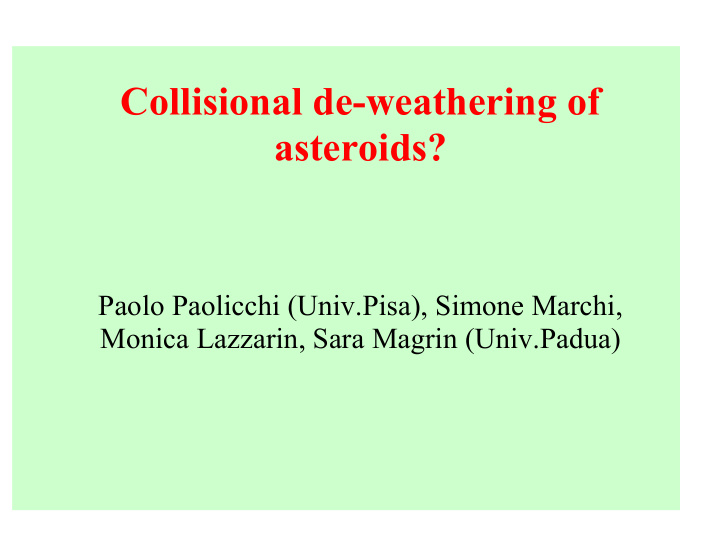



Collisional de-weathering of asteroids? Paolo Paolicchi (Univ.Pisa), Simone Marchi, Monica Lazzarin, Sara Magrin (Univ.Padua)
Introduction In a series of recent papers our group has analyzed the effects of the so-called space weathering on the spectral properties of Main Belt and Near Earth Asteroids. The spectral slope appears to be correlated to the exposure of the asteroids to the weathering effects of the Sun.
Introduction - 2 The spectral slope is obtained from the observed spectra (and also, with different methods, from photometric data). The exposure is defined in terms of the mean distance from the Sun and of the mean age. The age of a Main Belt asteroid may be constrained by its collisional lifetime.
Introduction - 3 Also the Yarkovsky time (i.e. the time required for a significant orbital evolution, maybe causing injection into major resonances) may play a role, but only for the smallest bodies (at least for Main Belt).
From Marchi et al. 2006 AJ 131,1138
Introduction - 4 Given the collisional lifetime, the mean age of a MB asteroid can be estimated with a formula inspired to the classical “optical depth” computations (see AJ paper). The age can be used to compute the exposure and thus to obtain a slope-exposure plot for different types of asteroids.
From Lazzarin et al. 2006 ApJ 647, 179L
Other effects A more detailed analysis introduces some additional effects acting on the spectral properties: _ (especially for NEAs) close encounters with other bodies (mainly planets) may alter the surface, causing a sort of de-weathering.
From Paolicchi et al. 2007, A&A 464,1139
Other effects - 2 _ (Especially for NEAs) Passing very close to the Sun introduces heating effects. They may be invoked to explain other spectral effects, such as the quasi complete absence of hydration features on C-type NEAs (Marchi et al., S236 Proc. and in preparation).
From Paolicchi et al. 2007, A&A 464,1139
Other effects - 3 _ Another, general effect, is connected to collisions. We have two reasons for it: in principle, between two disrupting events i.e. during the lifetime of an asteroid, we have many minor collisions, causing cratering, partial shattering and all that. These collisions should affect the surface directly and indirectly.
Other effects - 4 There also is a second argument: while in general our models represent a convincing and coherent scenario, also in connection with the meteorites and with laboratory experiments, there is a severe discrepancy between the timescales for which the observational slope increases to a partial saturation (also by for large bodies) and those suggested by laboratory
Other effects - 4 experiments (of the order of not many My). The most convincing explanation can be connected with the de-weathering effect of minor (also cratering) collisions. A thorough theoretical analysis is urged. At a very preliminary and qualitative stage a figure explains the effect.
Collisional de-weathering - 1
Collisional de-weathering-2 _ The interaction between partially de-weathering collisions with the general weathering effect may result into a slower increase of the slope. However, this is not the only possible explanation. _ Maybe the mean age or lifetime to be used in the exposure plots is not the time between two catastrophic processes.
Collisional de-weathering - 3 _ The “effective age” might be connected to the rejuvenation of a thin surface layer through infall of dust and regolith created by less energetic collisions; a -by far- more frequent process, maybe with a timescale comparable to the laboratory timescales. Maybe this time scales with the size similarly as the collisional lifetime.
Conclusions _ The spectral alterations are due not only to the space weathering but also to other effects (close encounters, heating, collisions) sometimes causing rejuvenation of the surface. _ The effect of collisions might be the most general, but a lot of additional theoretical work and modelling has to be done.
Recommend
More recommend